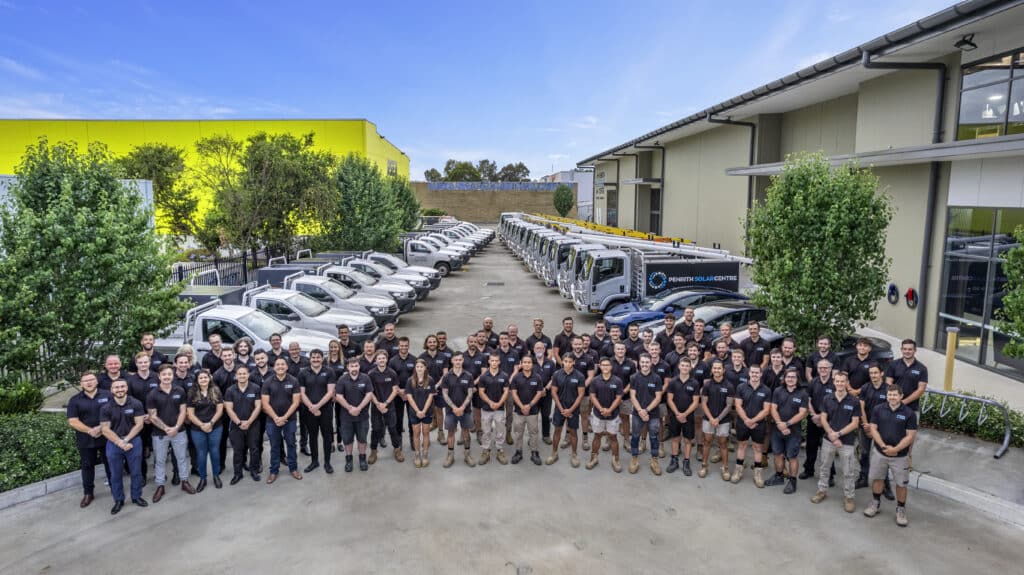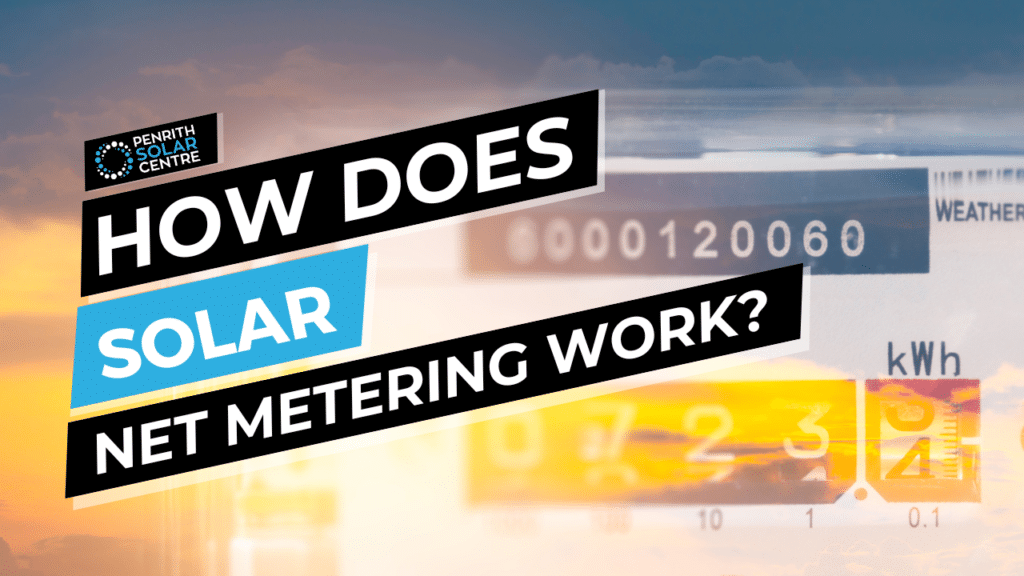
There are more than a few technical concepts to wrap your head around as you’re learning about solar systems. This is especially the case as you consider how your system will interact with the electrical grid. The electricity requirements alone are a bit daunting to understand, and in understanding those requirements, you’ll come across a concept called “net metering.”
What is it?
In short, it’s a process that measures electricity between your home and the grid to figure out how much is being imported or exported.
If that sounds kind of complex, don’t worry.
At Penrith Solar Centre, we know all about net metering, and how it interacts with your solar system, the main switchboard, and the grid – things we understand comprehensively. As you dive deeper into your solar journey, we’re here to guide you through the more complex electrical issues your installation will take.
In this article, you will learn:
- What is Net Metering for Solar?
- How Are Single-Phase and Three-Phase Connections Different?
- Net Metering in Single-Phase and Three-Phase Homes
- Net Metering and Battery Storage
By the end of this article, you’ll be able to meter all your nets. Strike that and reverse it. You’ll be an expert in all things net metering related.
What is Net Metering for Solar?
Net metering keeps track of when electricity comes and goes through the smart meter from the home to the grid or from the grid to the home. This is crucial once you install a solar system.
Net metering tracks when your home uses electricity. When you invest in solar, your energy retailer will install a smart meter, which includes a SIM card. By being connected to the internet, there is no need for someone to go to your home and read the meter.
The smart energy meter calculates the net energy usage by subtracting the surplus electricity generated from the total energy consumed. If you instantaneously generate more electricity than you consume, the meter records a net surplus.
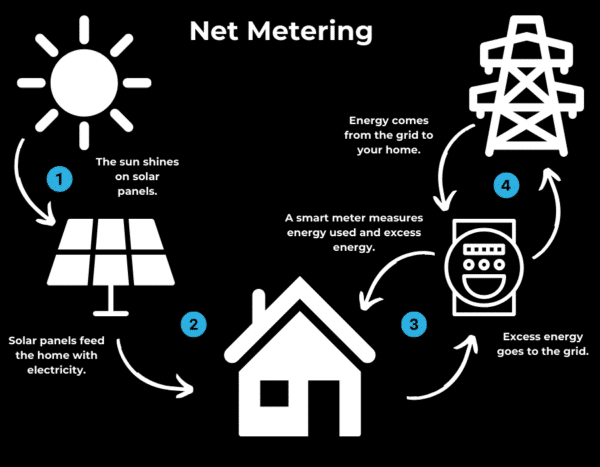
Smart meters are helpful if you have a second meter for off-peak electricity. The smart meters eliminate the need to have a second meter to monitor the off-peak electricity imported to heat your hot water system at night when electricity is cheaper. Smart meters record all electricity coming and going from your home, so you are charged appropriately at different times of day by your energy retailer.
Smart meters are wonderful for battery storage (if you have one installed). If you are practising consumption monitoring (and you really should be!), you can program your battery to work with the smart meter to import and export energy from the grid when it is best for you – importing when it’s least expensive and exporting when it’s most beneficial to you.
If you’re interested in learning more about smart meters, you should definitely check out the following article (which I just summarised in very broad strokes) titled, Smart Meters and Solar.
How Are Single-Phase and Three-Phase Connections Different?
Before getting into more about net metering, we need to pause and explain what single-phase and three-phase connections are and how they relate to your home.
Let’s look at the differences between single-phase and three-phase. Single-phase means there’s one active conductor (wire) coming to the home from the street and one neutral conductor (wire). With a single-phase connection, you can only buy or sell energy through that single active conductor.
Now, about 50% of Australian homes are three-phase. In a three-phase setup, you have three active conductors (wires) or phases—A, B, and C. A is red, B is white, and C is blue. You get energy from any of these phases. Still, there’s only one neutral conductor (wire) serving as the return path for all the energy.
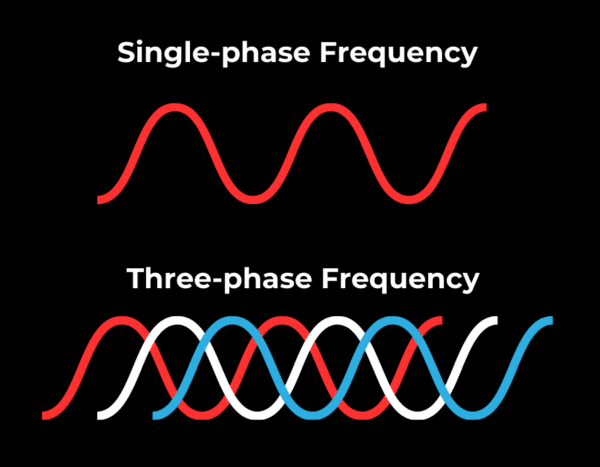
In practical terms, for three-phase, you’ll typically see four wires coming in, while for single-phase, you’ll see two wires. This difference in wiring is what defines the distinction between single-phase and three-phase.
If you’re interested in learning more about single-phase and three-phase connections to your home, you might want to check out the following article titled, Single-Phase vs. Three-Phase: How Are They Different?
Net Metering in Single-Phase and Three-Phase Homes
If you have a single-phase solar system installed, when you generate solar energy and immediately consume it, the net meter remains unaware of this consumption. Nothing is exported to the street. It happens “behind the meter,” meaning the retailer doesn’t track the energy you produce and self-consume. Only your private monitoring app holds this data.
For single-phase homes, the connection to the street is determined by the house number. House #1 connects to A phase, #2 to B phase, and #3 to C phase – all in a row. This pattern continues as you move down the block — #10 connects to A phase, #20 to B phase, #30 to C phase, and so on. Even with three-phase homes interspersed between single-phase homes, the connection pattern remains consistent in your neighbourhood.
A single-phase string inverter will frequently be installed on one of the three-phase conductors (wires). If you connect a single-phase string inverter to A, B, or C phase, it won’t directly feed the other two phases. Net metering comes into play here. The meter doesn’t care which phase you consume energy on; it only registers the net result across all three phases. The same principle applies when selling energy. For instance, if you use 2kW on A, 2kW on B, and 2kW on C, the meter sees a total usage of 6kW.
Now, let’s say you’ve got a 5kW inverter that is producing 100% of your solar, and let’s use the same 6kW load we used as an example in the paragraph above. That 5kW inverter is on A phase, and it’s producing 5kW. That’s awesome.
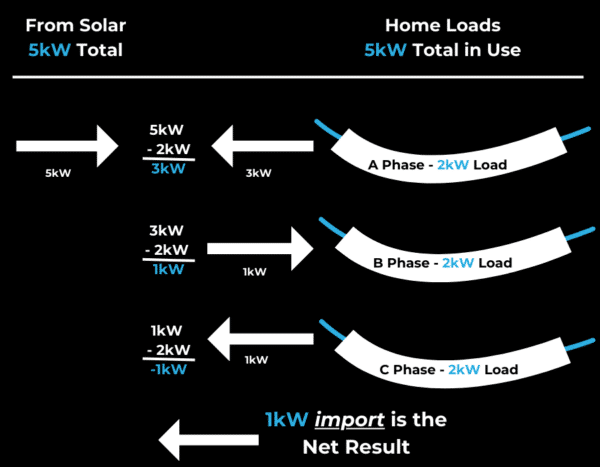
If the 5kW inverter is on A phase, and that phase is using (consuming) 2kW (from the example used in the paragraph above), then the 5kW inverter would supply A phase with 5kW – cancelling out the 2kW from the grid. This leaves 3 kW left over. What happens to those 3kW?
You’ll be able to use that 3kW to cross out B phase which is 2kW. 2kW will go to B phase and the remaining 1kW will go to C phase. The transfer of that energy is instantaneous (or at least seems instantaneous to us).
The instantaneous transfer allows this energy to cancel out usage on B and C phases, resulting in a net import of only 1kW from the grid. It’s important to note that only the numbers are exchanged, not electricity.
The meter doesn’t discriminate in order of where the electricity goes, it just happens in numbers because it’s instantaneous. You are giving those 5kW to the street while the street is simultaneously giving you 6kW of energy. 1kW of energy is being imported from the grid and that is the net result.
In a three-phase home, all three phases (wires) — A, B, and C — are connected to the street, along with the neutral wire.
At Penrith Solar Centre, we always install a three-phase solar system on three-phase sites.
You would think that setting up a three-phase system on a three-phase site would be perfectly balanced and happy days. This is not the case. You still very heavily rely on your net metering. It’s very, very, very unusual for all three phases from the street to have the same demand. Sure, a three-phase air conditioner will use a nearly even load across all three phases, however, appliances like ovens, microwaves, and electric heaters are typically single-phase and draw electricity from any of the phases.
Here’s another example: you use 7 kW on A phase, 1 kW on B, and 3 kW on C. The meter only cares about the total, which is 11 kW. And your solar system will produce evenly across all three phases.
Here’s where it gets fun. Let’s say that you have a 10kW system and it’s got a 10kW inverter capacity and combined they’re pumping out 100% of those 10kW. That would mean you’ve got 3.3kW per phase being generated by the solar.
Let’s look at the B and C phases first. On the C phase, there’s 3.3kW coming from the solar and 3kW of load on that phase, leaving you with 0.3kW. On the B phase, there’s 3.3kW coming from the solar and 1kW of load, leaving you with 2.3kW. So that’s 2.6kW total coming from the solar.
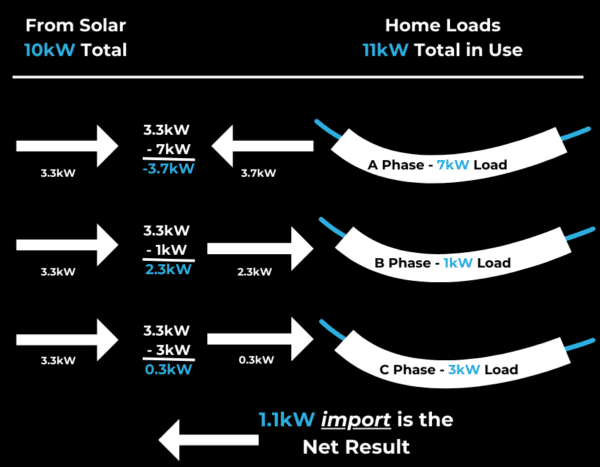
When you add the 2.6kW that are left over from B and C phases and add it to A phase’s 3.3kW (because it’s gotta go somewhere), you’re left with 5.9kW total from the solar that is being sent to the A phase load of 7kW. So the net result is 1.1kW which you are still importing because of the total energy you are using.
The system understands the total contribution (or self-consumption) versus the total grid import without differentiating on individual phases.
Enphase, our preferred choice of microinverter solar systems, effortlessly adapts between single-phase or three-phase with a simple trunking cable change.
A microinverter, essentially a single-phase inverter, connects to the roof using a trunking cable available in either single or three phases. For three-phase sites, the trunking cable organises micro inverters across A, B, and C phases in a repeating sequence (just like the houses on the street).
On a single-phase system, the trunking cable plugs in, following a consistent A phase sequence. Yet, with a three-phase system, you can accommodate three times the microinverters compared to a single-phase system.
As electricians, especially solar electricians, it’s crucial to install three-phase solar systems on three-phase sites. Opting for a single-phase system on a three-phase site is irresponsible and a budget-driven shortcut. It’s not the right approach, and we strongly discourage it.
Net Metering and Battery Storage
Considering the future of electric homes, at a time when solar is commonly being installed at an accelerated rate in New South Wales, it’s becoming more and more evident that the grid’s current structure won’t sustain increasing demands.
Multiple households exporting excess energy simultaneously can overwhelm the grid. Encouraging battery adoption and implementing export limitations are things homeowners can do to help reduce this strain as we move towards a more electric future.
It’s necessary to pay attention to your net metering through your smart meter and practice consumption monitoring as well. This attention to the input and output of your solar system empowers you to produce, store, and consume your energy efficiently. It also reduces reliance on the grid during peak times, which are typically between 5:00 to 7:00 in the evening.
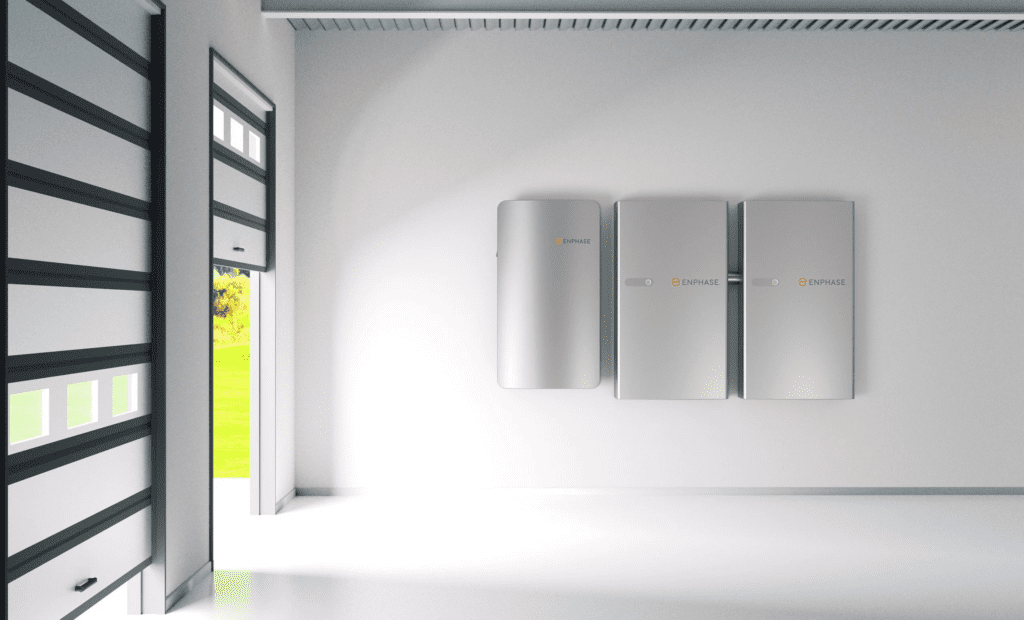
Solar battery storage functions on a single-phase conductor. Now, that doesn’t mean that you can only install a battery if you have single-phase connectivity to your home. A solar battery can only be installed on one phase (wire). Solar batteries rely heavily on net metering to cover all home loads on all phases (if you have a three-phase connection).
Let’s say you’ve got a 30kW system at home and you’re only using 10kW of it during the day, and it hits its peak of 30kW. That’s 20kW being sent out to the grid. Could you imagine if there were 10 neighbours in a row that were each exporting 20kW at any one time? That would be a total of 200kW pumped into the grid. At once. That’s a problem for Endeavour Energy, or for any DNSP.
Because of this excess energy being exported to the grid, a solar system with a solar battery is what homeowners need to adopt. Battery storage helps in personal energy usage and prevents sudden surges in grid exports in communities.
If you’re interested in learning more about how homeowners with solar batteries can help relieve the grid, you might want to check out the following article titled, What is a Virtual Power Plant (VPP)?
You Ain’t Seen Nothin’ Net: Wrapping It Up
Now that you understand the elusive concept known as net metering, you are better prepared to discuss meter upgrades with your retailer. Net metering is the transfer of electricity from your solar system to the grid. Smart meters, which facilitate net metering, are necessary when you install solar on your home. There are different considerations for net metering whether you have a single-phase connection or a three-phase one.
At Penrith Solar Centre, we understand the intricacies of net metering and the importance of getting a smart meter installed in order to maximise your energy consumption. We guide customers through every aspect of their respective solar journeys, including net metering.
If you’re interested in learning more about monitoring and maintaining the relationship between the grid and your solar system, you might want to check out the following article titled, What is Consumption Monitoring?
